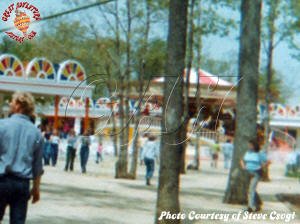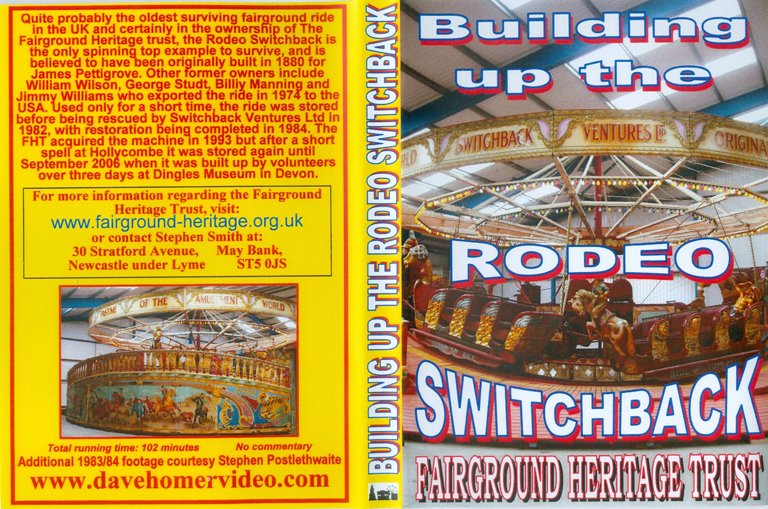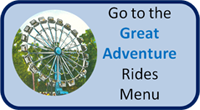
 One of the oldest rides to find its way to the carnivals of Europe was the roundabout, which was a simple spinning ride. Like most rides, variations on the original came along with new innovations creating new ride experiences. As ride technology changed, the older versions of the rides were often retired and lost to history, and the Gondola is a prime example of one of those primitive rides which somehow escaped extinction.
|
|
|
|||
| 1975: | 1976: | 1977: | |
 |
 |
 |
|
| Poster Map Images (above) & Pamphlet Map Images (below) | |||
 |
 |
 |
|
 |
In the 1800's as technology was making huge progress at a rapid rate, tool makers and machinery makers were always looking to create the next new thing that would revolutionize their industry. The development of steam engines for use in farming led to these machinists to look for other uses for existing technologies, and one of those uses was harnessing steam to power fair rides, which until that point had been hand or animal driven simple rides. Steam was first used to power carousels, and after the carousel took off with the public, the makers looked to create other "modern" rides. One of the pioneers of this industry in England was Frederick Savage, who went from creating simple farm tools, to steam tractors, and then onto carousels. Savage's carousels became well known all over England, and with their success he looked to build other types of rides. One of these rides was a roundabout, which featured vehicles in varying styles traveling around a central column. Builders tried unsuccessfully to add hills to these rides and create more excitement for riders, but Savage figured out how to make a system that would work reliably. The result of this was the Gondola ride which he patented and collected royalties from other manufacturers. Gondola rides featured many styles of ride vehicles ranging from animal shapes to automobiles. They shared a common style which featured a round undulating track with two hills and two valleys. The structure of the ride was suspended like a carousel, with a structure radiating from the central hub that rotated with the ride. This structure featured rounding boards like a carousel and a canvas umbrella roof overhead which like a carousel spun with the ride. This was known as a "spindletop" style gondola ride. Later versions of the rides featured stationary roof structures. |
 |
|
 |
 |
||
 |
 |
||
 |
 |
||
 |
 |
||
 |
 |
||
 |
%20copy_small.jpg) |
 |
|
%20copy_small.jpg) |
%20copy_small.jpg) |
%20copy_small.jpg) |
|
 |
Originally the rides were steam powered, with the central hub of the ride also serving as a chimney for the coal fired steam engine. The steam engine featured dual cylinders driving a flywheel which powered the ride. The steam engine also powered an elaborate band organ which provided lively music to make the ride even more exciting. Over time with the introduction of electric motors, the steam engines were replaced as the rides were electrified. The Gondola, also known as the Rodeo Switchback, was built around 1880. Originally while touring the English fair circuit it was known as the Dragons, with each off the ride vehicles featuring the head of a mythical beast. During the mid 1920's the ride was retrofitted with an electric drive motor replacing the steam engine, and the ride vehicles were remodeled with additional figures being added to the rear of each car. The new character figures were images of the big silent film stars of the day and included Harold Lloyd, Jackie Coogan and Tom Mix alongside figures of animals.
|
%20copy_small.jpg) |
|
%20copy_small.jpg) |
%20copy_small.jpg) |
||
%20copy_small.jpg) |
%20copy_small.jpg) |
%20copy_small.jpg) |
|
%20copy_small.jpg) |
The Rodeo Switchback continued to travel the fairs of England, and was purchased just after World War II ended, and it was remodeled again, this time with new painted scenes of the wild west and animals on the center panels and rounding boards around the top. The ride was renamed "Electric Rodeo and Switchback" and after continuing to tour for several years, it found a home in a seaside amusement park until 1973. After nearly 20 years at the park it fell into a state of disrepair and was sold to another fair company. At this point the ride received an extensive rehab and spent the 1974 season on the English fair circuit until it was sold for $100,000 to Great Adventure at the end of the season. %20copy_small.jpg) In 1975 the Gondola was shipped along with its traveling vehicles to New Jersey. Once at Great Adventure, extensive work was done to modernize the ride's electric systems as well as to preserve the historic ride. It was originally hoped to have the ride running in the park for the 1975 season, and was even shown on the park map, but restoration efforts took longer than anticipated. |
%20copy_small.jpg) |
|
%20copy_small.jpg) |
%20copy_small.jpg) |
||
%20copy_small.jpg) |
%20copy_small.jpg) |
||
%20copy_small.jpg) |
%20copy_small.jpg) |
%20copy_small.jpg) |
|
 |
 |
||
 |
As part of the restoration effort while at Great Adventure, the original ride figures were carefully duplicated in fiberglass for use in the park, protecting the original wooden carvings that had become fragile with age. All of the electrical systems including the hundreds of light sockets were updated and replaced. The ride's huge 81-key Gaviola band organ was refurbished and expanded with additional pipes being added by an organ specialist. After all the restoration work was completed, the Gondola finally made its debut at Great Adventure for the 1977 season, taking center stage in the middle of the Fortune Festival games area. The Gondola was an interesting looking ride and unique as an antique show piece but lacked a lot of appeal to most park guests. Combined with the maintenance required for a nearly century old ride, it only ran in the park for one season and at the end of 1977, it was put into storage. |
 |
|
 |
 |
||
 |
|||
| Click the placard below to watch a
brief video segment excerpt about the Rodeo Switchback at Great Adventure.  Click HERE to order a copy of the "Building up the Rodeo Switchback" DVD. |
|||
 |
|||
 |
|||
 |
|||
 |
In 1982 a consortium was formed to
rescue this important, historic ride, and return it to the UK before it
was destroyed. This was successful, and Switchback Ventures was set up
to restore and operate the ride. It made its debut at the Great Dorset
Steam Fair in 1984, and continued to travel for seven years. In 1992 the
decision was made to sell the ride, and in 1993 it was acquired by
another entity which ran the ride for the 1994 season before putting it
back into storage. The ride finally made its way to Dingles Fairground Heritage Centre in England. There it has been preserved and restored where it runs as part of a museum and it is recognized as one of the world's oldest fair rides.
|
 |
|
 |
 |
||
 |
 |
||
 |
Watch video of the Rodeo Switchback in operation at Dingles Fairground Heritage Centre: |
||
 |
|||
 |
|||
 |
 |
 |